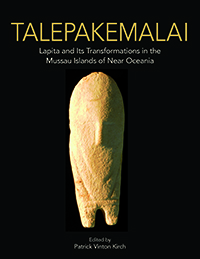Notes
Note: For 1988 samples (SB-1 to -4 and LB-1 to -5) the % Silt column includes both silt and clay grain size fractions.
Item record
Documentation
Sedimentology Methods
Field sampling of archaeological sediments followed methods outlined by Stein (1985, 1987), with samples taken from discrete depositional layers (i.e., not crossing stratigraphic boundaries). Samples were collected into sterile polyethylene bags after the stratigraphic section of particular excavation units had been drawn; sample locations were indicated by depth and notated on the stratigraphic drawings.
Modern Control Samples. Four sets of modern control samples were collected, all from Eloaua Island. (1) In 1985 we obtained general samples (GS-1 to -3) from the foot of a seaward beach, and two from the top and foot of a lagoon beach, respectively. (2) In 1986, we collected four samples along a measured transect across the seaward reef flat in front of the Talubagalim School, located due west of the ECA site and fronting the Malle Channel. These samples (designated RT-1 to -4) were obtained from the seaward beach slope (RT-1), the “muck zone” containing organic materials 15 m from the beach (RT-2), the “seagrass zone” 50 m from the beach (RT-3), and the outer zone marked by the presence of dead branch coral, 80 m from the beach (RT-4). (3) In 1988, we took four samples along the slope of the seaward beach in front of Ave Male’s hamlet, with the elevation of samples above the reef flat determined by Lietz telescopic level. The positions of these samples (designated SB-1 to -4), and the topographic profile of this seaward beach, are shown in Figure 3.38A. (5) Also in 1988, we took five samples along the modern Eloaua lagoon beach on the west side of the island near site ECA. As with the previous sample set, these lagoon beach samples (designated LB-1 to -5) were precisely plotted along a topographic transect, as depicted in Figure 3.38B. These control samples, from a seaward beach, seaward reef flat, and lagoon beach, provide comparative data for the interpretation of the archaeological sediment samples.
Analytical Methods. Sediment color was described using the Munsell system (both moist and dry). Hydrogen ion content (pH), which indicates relative acidity or alkalinity, was determined using an automatic Altex 70 pH meter, following the procedures of Jackson (1958). Pretreatment to remove organic matter, prior to grain-size analysis, followed the method of Jackson (1958), with the substitution of sodium hydrochlorite for hydrogen peroxide.
Following pretreatment, samples were oven dried at 100º C. A solution of sodium hexametaphosphate (a dispersing agent) and distilled water was added to the dried sediment; flasks were mechanically shaken for 5 minutes, then allowed to sit overnight to insure that flocculation was not a problem. Samples were wet-screened using a 4φ geologic sieve to separate the sand fraction from the silt and clay fractions. The sand fractions were oven dried and mechanically shaken for 15 minutes through nested geologic sieves with mesh sizes of -2, -1, 0, 1, 2, 3, and 4φ. The resulting sand fractions were weighed on an analytic balance to the nearest thousandth of a gram.
The silt-clay fraction was placed in 1,000-ml cylinders and sufficient sodium hexametaphosphate solution was added to fill the cylinders. The pipette method of Shackley (1975) was used to determine grain size for this finer fraction. The time-consuming pipette method was used only for the 1985 and 1986 samples. The 1988 samples were analyzed only by mechanical sieving.
Statistical analysis of grain-size data was performed using a computer program developed by the University of Washington geoarchaeology laboratory, which calculated and plotted frequency and cumulative percentage plots by φ size, as well as providing summary textural designations, sample kurtosis, and sorting characteristics (based on Folk 1974).
Reuse
Kirch, Patrick V., 2021. Table S3.1. Analytical data for modern sediment control samples for Talepakemalai: Lapita and its Transformations in the Mussau Islands of Near Oceania. Version 1. Cotsen Institute of Archaeology Press. https://doi.org/10.25346/S6/LUZ8UF
